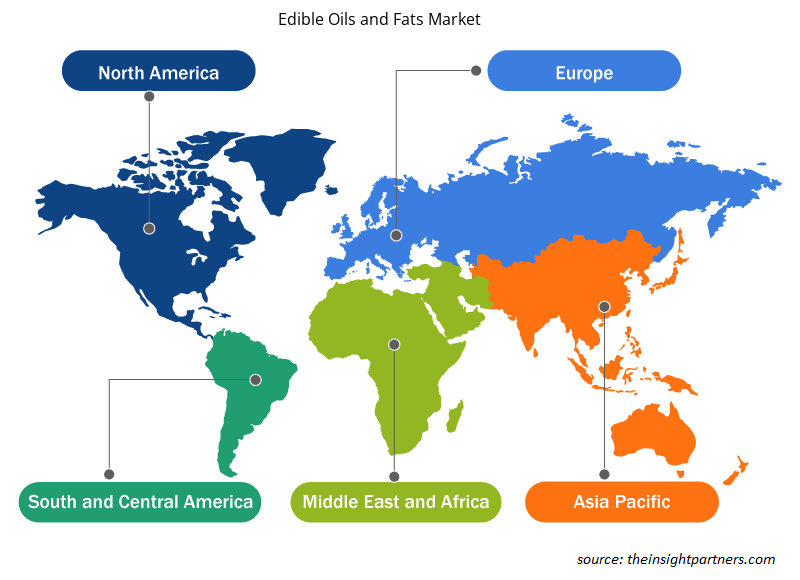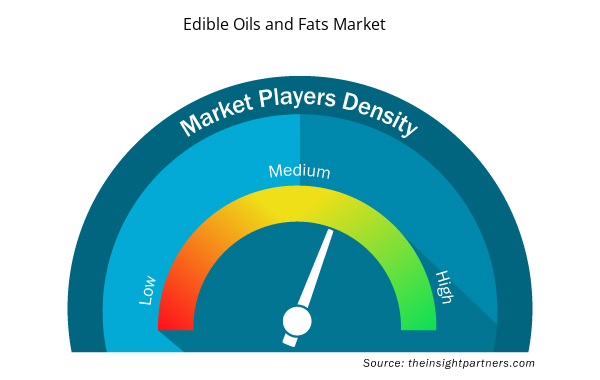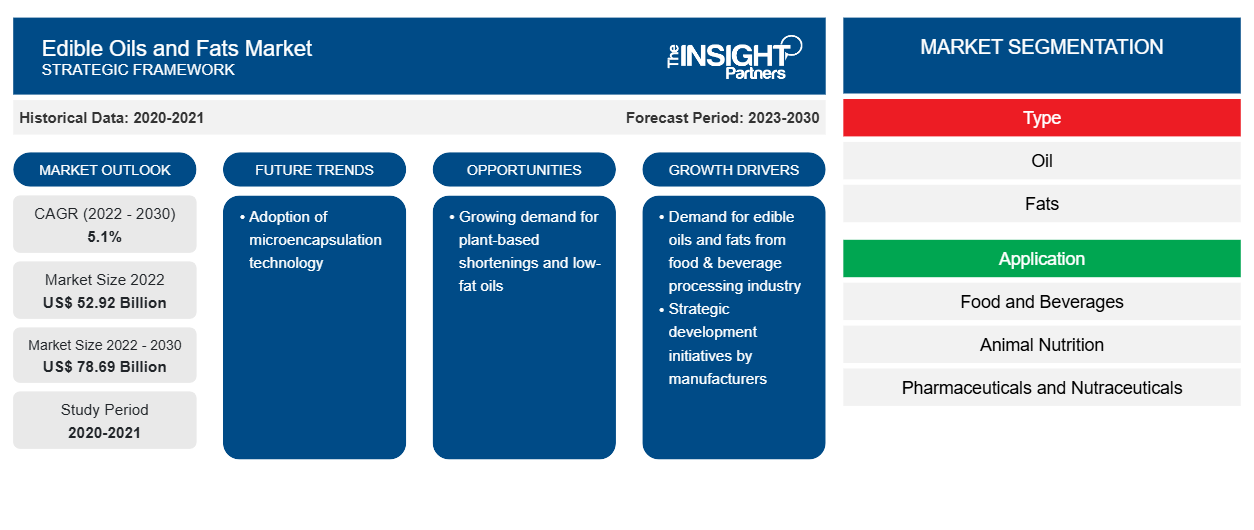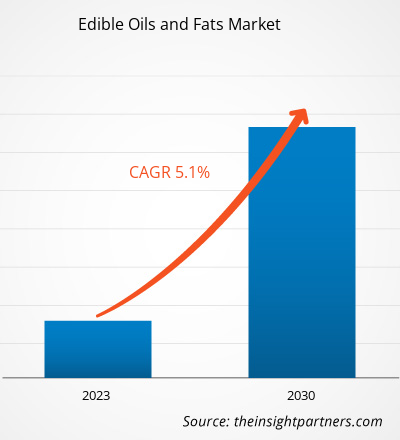[調査レポート] 食用油脂市場は、2022年の529億2,000万米ドルから2030年には786億8,661万米ドルに成長すると予想されており、2023年から2030年にかけて5.1%のCAGRを記録すると予想されています。
市場洞察とアナリストの見解:
食用脂肪は、豚脂(ラード)や獣脂などの動物由来の原料、または植物由来の原料から得られます。食用動物由来脂肪の製造業者にとって、食肉加工業者は原料の供給業者です。製造業者は、原材料の途切れない供給のために、食肉加工業界と長期契約を結んでいます。豚肉や牛肉の脂肪組織は細かく切り刻まれ、蒸気蒸解釜で煮られ、脂肪が水中に放出されます。脂肪は水面に浮かび、すくい取って集められます。動物組織の膜状物質は油圧プレスで圧縮され、さらに脂肪が得られます。脂肪は、脱泥遠心分離機で液相から分離されます。
マーガリンなどの植物性脂肪は、大豆油、コーン油、またはベニバナ油を水素化して得られます。まず、油を漂白土または木炭で漂白して、不快な臭いや色を取り除きます。次に、高圧の水素ガスに通して油を固め、マーガリンを得ます。植物性油脂の製造にはさまざまなプロセスがあります。
精製された食用油脂は容器に詰められ、販売業者やサプライヤーを通じて食品・飲料、動物栄養、医薬品・栄養補助食品業界などの最終ユーザーに送られます。カーギル社、バンジ社、ADM、不二製油株式会社、花王株式会社は、世界中の食用油脂の主要メーカーです。
成長の原動力と課題:
米国農務省(USDA)によると、大豆油は2番目に多く消費されている植物油です。揚げ物、調理、ショートニング、マーガリンに広く使用されています。経済協力開発機構(OECD)によると、2022年の植物油の消費量は2億4,900万トンに達し、食品部門が大きなシェアを占めています。さらに、菓子業界ではバターを主原料として多く使用しており、マーガリンがそれに続きます。高品質の食用油脂は、パンや菓子、乳製品や冷凍デザート、スナック、すぐに食べられる(RTE)食事や調理済み(RTC)食事、その他の食品や飲料に使用されています。精製油脂は脂質の豊富な供給源です。そのため、用途の増加と世界人口の増加により、精製油脂の使用が増加しています。
北米やアジア太平洋などのさまざまな地域の食品・飲料業界は、持続可能性への傾向の高まり、利便性とすぐに食べられる製品への好み、オーガニック製品と植物由来製品の採用の増加により、継続的に成長しています。業界では、急速に変化する消費者の好みに対応するために、プロセス、製品、サービスの革新により大きな動きが見られます。米国国勢調査局によると、2020年の米国には39,646の食品および飲料製造工場がありました。そのうち、カリフォルニア、テキサス、ニューヨークにはそれぞれ6,116、2,625、2,600がありました。同様に、食品・飲料業界は欧州経済に大きく貢献している業界の1つです。したがって、世界中で成長する食品・飲料業界は、食用油と脂肪の需要を促進します。
要件に合わせてレポートをカスタマイズする
このレポートの一部、国レベルの分析、Excelデータパックなど、あらゆるレポートを無料でカスタマイズできます。また、スタートアップや大学向けのお得なオファーや割引もご利用いただけます。
- このレポートの主要な市場動向を入手してください。この無料サンプルには、市場動向から見積もりや予測に至るまでのデータ分析が含まれます。
レポートのセグメンテーションと範囲:
「世界の食用油脂市場」は、種類、用途、地域に基づいてセグメント化されています。種類に基づいて、市場は油脂に分かれています。用途に基づいて、世界の食用油脂は、食品および飲料、動物栄養、医薬品および栄養補助食品に分かれています。油セグメントは、世界の大きなシェアを占めています。devided into food and beverages, animal nutrition, and pharmaceuticals and nutraceuticals. The oil segment held a larger share of the global
食用油脂市場
2022年。地理に基づいて、食用油脂市場は、北米(米国、カナダ、メキシコ)、ヨーロッパ(ドイツ、フランス、イタリア、英国、ロシア、その他のヨーロッパ)、アジア太平洋(オーストラリア、中国、日本、インド、韓国、その他のアジア太平洋)、中東およびアフリカ(南アフリカ、サウジアラビア、UAE、その他の中東およびアフリカ)、南米および中米(ブラジル、チリ、その他の南米および中米)に分類されます。
セグメント分析:
食用油脂市場は、種類別に油脂と脂肪に分かれています。油脂セグメントは、2022年に食用油脂市場で大きなシェアを占め、予測期間中に高いCAGRを記録すると予想されています。植物油は、種子、穀物、ナッツ、果物から抽出できます。オリーブ、ヒマワリ、パーム、キャノーラ、ココナッツ、ベニバナ、トウモロコシ、ピーナッツ、綿実、パーム核、大豆油は、最も消費されている油です。一般的に、植物油は食品の調理に使用され、風味のために原油が加えられます。植物油は、動物飼料の製造にも使用されます。パーム油は安定化しやすく、加工食品の風味の品質と一貫性を維持します。そのため、食品メーカーに好まれることが多いです。インドネシア、マレーシア、タイ、ナイジェリアは、最大のパーム油生産国および輸出国です。水素添加植物油に含まれるトランス脂肪酸に関連する健康上の懸念に関する意識の高まりにより、食品業界でのパーム油の使用が促進されています。農業食品産業はパーム油の重要な消費者であり、主に工業用焼き菓子、チョコレート製品、菓子、アイスクリーム、さらにはダイエット食品の代替品に使用されています。パーム油はトコフェロールとカロテノイドが豊富に含まれており、酸化劣化に対する自然な安定性をもたらします。したがって、さまざまな最終用途産業におけるパーム油の利点と用途により、世界中で需要が高まっています。
地域分析:
食用油脂市場は、北米、ヨーロッパ、アジア太平洋、中南米、中東アフリカの5つの主要地域に分割されています。世界の食用油脂市場は中南米が主流で、2022年には約4兆5,000億米ドルになると推定されています。中南米の食用油脂市場は、ブラジル、アルゼンチン、その他の中南米に分割されています。この地域のスナック食品部門は、冷凍スナック、風味スナック、フルーツスナック、菓子スナック、ベーカリースナックなど、さまざまなスナックオプションに対する消費者の好みが高まっているため、拡大しています。食用油脂は、食品に独特の風味を与え、スナックの製造においてユニークで望ましい機能を提供するため、重要な役割を果たしています。たとえば、油は揚げ物の揚げ媒体であり、ペストリーでは、小麦粉やその他の材料が固まるのを防ぐために植物油ベースのショートニングが追加されます。したがって、さまざまなスナックに対する需要の高まりと食用油脂に関連する利点により、南米および中米のスナック部門における食用油脂の需要が促進されています。
さらに、動物栄養などの最終用途産業における食用油脂の需要は、南米および中米で増加しています。Oil Worldによると、2022年に中国は主に動物性タンパク質の消費のためにブラジルの大豆油の約70%を購入しました。さらに、動物栄養、医薬品、栄養補助食品産業の拡大により、特殊な食用油脂の需要が高まっています。これらの業界では、動物飼料配合や医薬品配合など、さまざまな用途に特定の種類の油が必要です。これらのセクターが成長し、多様化するにつれて、独自の要件に対する需要が増加し、南米および中米の食用油脂市場の成長を促進します。
業界の発展と将来の機会:
世界の食用油脂市場で活動する主要企業が行っているさまざまな取り組みを以下に示します。
- 2021年10月、米国の有力食用油脂メーカーの1つであるADMは、食品および飼料業界からの大豆油の需要の急増に対応するため、ノースダコタ州に初の専用大豆粉砕工場と精製所を建設する計画を発表しました。
- 伊藤忠商事株式会社(本社:日本)は、2021年12月、米国ニューヨークに本社を置く伊藤忠インターナショナル株式会社を通じて、米国にフジオイルインターナショナル株式会社を設立することに合意したことを発表しました。これにより、同社は北米における油脂事業の強化を図ります。
食用油脂市場の地域別分析
予測期間を通じて食用油脂市場に影響を与える地域的な傾向と要因は、Insight Partners のアナリストによって徹底的に説明されています。このセクションでは、北米、ヨーロッパ、アジア太平洋、中東、アフリカ、南米、中米にわたる食用油脂市場のセグメントと地理についても説明します。

- 食用油脂市場の地域別データを入手
食用油脂市場レポートの範囲
| レポート属性 | 詳細 |
|---|---|
| 2022年の市場規模 | 529.2億米ドル |
| 2030年までの市場規模 | 786.9億米ドル |
| 世界のCAGR(2022年 - 2030年) | 5.1% |
| 履歴データ | 2020-2021 |
| 予測期間 | 2023-2030 |
| 対象セグメント | タイプ別
|
| 対象地域と国 | 北米
|
| 市場リーダーと主要企業プロフィール |
|
市場プレーヤーの密度:ビジネスダイナミクスへの影響を理解する
食用油脂市場は、消費者の嗜好の変化、技術の進歩、製品の利点に対する認識の高まりなどの要因により、エンドユーザーの需要が高まり、急速に成長しています。需要が高まるにつれて、企業は提供品を拡大し、消費者のニーズを満たすために革新し、新たなトレンドを活用し、市場の成長をさらに促進しています。
市場プレーヤー密度とは、特定の市場または業界内で活動している企業または会社の分布を指します。これは、特定の市場スペースに、その規模または総市場価値と比較して、どれだけの競合相手 (市場プレーヤー) が存在するかを示します。
食用油脂市場で事業を展開している主要企業は次のとおりです。
- バンジ株式会社
- アーチャー・ダニエルズ・ミッドランド社
- 不二石油株式会社
- 花王株式会社
- AAKAB
免責事項:上記の企業は、特定の順序でランク付けされていません。

- 食用油脂市場のトップキープレーヤーの概要を入手
COVID-19パンデミックの影響:
COVID-19パンデミックは、さまざまな国の経済や産業に影響を及ぼしました。北米、ヨーロッパ、アジア太平洋(APAC)、中南米、中東アフリカ(MEA)の主要国でのロックダウン、渡航禁止、事業停止は、食品・飲料業界を含むさまざまな業界の成長に悪影響を及ぼしました。製造ユニットの停止により、グローバルサプライチェーン、製造活動、配送スケジュール、さまざまな必須製品と非必須製品の販売が混乱しました。さまざまな企業が、2020年に製品の配送が遅れ、製品の将来の販売が低迷する可能性があると発表しました。さらに、ヨーロッパ、アジア、北米のさまざまな政府による海外旅行の禁止により、企業はコラボレーションとパートナーシップの計画を一時的に保留せざるを得ませんでした。これらすべての要因が2020年と2021年初頭の食品・飲料業界を妨げ、食用油脂市場の成長を抑制しました。
競争環境と主要企業:
Bunge Ltd、Archer-Daniels-Midland Co.、Fuji Oil Co Ltd、Kao Corp、AAK AB、J-Oil Mills Inc、Cargill Inc、Olam Group Ltd、ConnOils LLC、Louis Dreyfus Co BV は、世界の食用油脂市場で活動している著名な企業です。これらの食用油脂メーカーは、革新的な機能を備えた最先端の抽出ソリューションを提供し、消費者に優れた体験を提供しています。
- 過去2年間の分析、基準年、CAGRによる予測(7年間)
- PEST分析とSWOT分析
- 市場規模価値/数量 - 世界、地域、国
- 業界と競争環境
- Excel データセット



Report Coverage
Revenue forecast, Company Analysis, Industry landscape, Growth factors, and Trends

Segment Covered
This text is related
to segments covered.

Regional Scope
North America, Europe, Asia Pacific, Middle East & Africa, South & Central America

Country Scope
This text is related
to country scope.
よくある質問
Manufacturers of edible fats and oils invest significantly in the expansion of business and production capacity to serve their customer base better and meet their consumer requirements. In December 2021, ITOCHU Corporation, headquartered in Japan, announced their agreement through ITOCHU International Inc., headquartered in New York, US, for the establishment of Fuji Oil International Inc. in the US. With this agreement, the firm plans to strengthen the oil and fat business in North America.
Based on type, oil segment mainly has the largest revenue share. Vegetable oils can be derived from seeds, cereal grains, nuts, and fruits. The most consumed oils are olive, sunflower, palm, canola, coconut, safflower, corn, peanut, cottonseed, palm kernel, and soybean. Generally, vegetable oils are used in food preparation, and crude oil is added for flavor. Vegetable oil is also used in the production of animal feed.
The major players operating in the global edible oils and fats market are are Bunge Ltd, Archer-Daniels-Midland Co, Fuji Oil Co Ltd, Kao Corp, AAK AB, J-Oil Mills Inc, Cargill Inc, Olam Group Ltd, ConnOils LLC, and Louis Dreyfus Co BV.
Consumers consider plant-based products healthier than conventional products. Rising health consciousness among consumers propels the demand for plant-based and low-fat products. Thus, manufacturers develop plant-based shortenings and low-fat oils to cater to the rising demand. Plant-based shortenings are non-hydrogenated and do not contain cholesterol and trans-fat. Thus, it is considered a healthier alternative to conventional shortenings. Moreover, the increasing prevalence of cardiovascular diseases, obesity, and diabetes over the years is expected to boost the demand for low-fat products such as low-fat oils among various industries, including bakery & confectioneries, dairy & frozen desserts, and snacking.
Asia Pacific accounted for the largest share of the global edible oils and fats market. The market growth is attributed to increasing demand for bakery products, especially breads, cakes, pastries, and muffins, coupled with the growing influence of Western culture on the millennial and Gen-z population in the region. The bakery sector in China witnessed tremendous growth, with retail sales of bakery products accounting for US$ 34 billion in 2020, according to the United States Department of Agriculture (USDA). Moreover, manufacturers of edible oils and fats actively operate across the region and offer edible oils and fats made with fine-quality oil or its fractions. Distinct melting profiles of butter and margarines, packaging types, and the expansion of antifoaming or antioxidant agents of edible oils and fats are available across the region and widely applicable in many end-use industries such as confectionery, bakery, dairy, and infant nutrition.
Based on the application, food and beverages segment is hold a significant share in the market. The demand for edible oils and fats, such as shortenings, is gradually increasing in bakery and confectionery segment as they lubricate the structure of bakery products and shorten or tender flour proteins. Fats and oils in the mixture hold many air cells incorporated during creaming, making the products smooth and creamy. Fats act as enriching agents, add calorie value to baked foods, and develop flakiness in products. The rising demand for baked products, including cakes, breads, cookies, and biscuits, significantly drives edible oils and fats utilization.
Trends and growth analysis reports related to Food and Beverages : READ MORE..
The List of Companies - Edible Oils and Fats Market
- Bunge Ltd
- Archer-Daniels-Midland Co
- Fuji Oil Co Ltd
- Kao Corp
- AAK AB
- J-Oil Mills Inc
- Cargill Inc
- Olam Group Ltd
- ConnOils LLC
- Louis Dreyfus Co BV
The Insight Partners performs research in 4 major stages: Data Collection & Secondary Research, Primary Research, Data Analysis and Data Triangulation & Final Review.
- Data Collection and Secondary Research:
As a market research and consulting firm operating from a decade, we have published and advised several client across the globe. First step for any study will start with an assessment of currently available data and insights from existing reports. Further, historical and current market information is collected from Investor Presentations, Annual Reports, SEC Filings, etc., and other information related to company’s performance and market positioning are gathered from Paid Databases (Factiva, Hoovers, and Reuters) and various other publications available in public domain.
Several associations trade associates, technical forums, institutes, societies and organization are accessed to gain technical as well as market related insights through their publications such as research papers, blogs and press releases related to the studies are referred to get cues about the market. Further, white papers, journals, magazines, and other news articles published in last 3 years are scrutinized and analyzed to understand the current market trends.
- Primary Research:
The primarily interview analysis comprise of data obtained from industry participants interview and answers to survey questions gathered by in-house primary team.
For primary research, interviews are conducted with industry experts/CEOs/Marketing Managers/VPs/Subject Matter Experts from both demand and supply side to get a 360-degree view of the market. The primary team conducts several interviews based on the complexity of the markets to understand the various market trends and dynamics which makes research more credible and precise.
A typical research interview fulfils the following functions:
- Provides first-hand information on the market size, market trends, growth trends, competitive landscape, and outlook
- Validates and strengthens in-house secondary research findings
- Develops the analysis team’s expertise and market understanding
Primary research involves email interactions and telephone interviews for each market, category, segment, and sub-segment across geographies. The participants who typically take part in such a process include, but are not limited to:
- Industry participants: VPs, business development managers, market intelligence managers and national sales managers
- Outside experts: Valuation experts, research analysts and key opinion leaders specializing in the electronics and semiconductor industry.
Below is the breakup of our primary respondents by company, designation, and region:

Once we receive the confirmation from primary research sources or primary respondents, we finalize the base year market estimation and forecast the data as per the macroeconomic and microeconomic factors assessed during data collection.
- Data Analysis:
Once data is validated through both secondary as well as primary respondents, we finalize the market estimations by hypothesis formulation and factor analysis at regional and country level.
- Macro-Economic Factor Analysis:
We analyse macroeconomic indicators such the gross domestic product (GDP), increase in the demand for goods and services across industries, technological advancement, regional economic growth, governmental policies, the influence of COVID-19, PEST analysis, and other aspects. This analysis aids in setting benchmarks for various nations/regions and approximating market splits. Additionally, the general trend of the aforementioned components aid in determining the market's development possibilities.
- Country Level Data:
Various factors that are especially aligned to the country are taken into account to determine the market size for a certain area and country, including the presence of vendors, such as headquarters and offices, the country's GDP, demand patterns, and industry growth. To comprehend the market dynamics for the nation, a number of growth variables, inhibitors, application areas, and current market trends are researched. The aforementioned elements aid in determining the country's overall market's growth potential.
- Company Profile:
The “Table of Contents” is formulated by listing and analyzing more than 25 - 30 companies operating in the market ecosystem across geographies. However, we profile only 10 companies as a standard practice in our syndicate reports. These 10 companies comprise leading, emerging, and regional players. Nonetheless, our analysis is not restricted to the 10 listed companies, we also analyze other companies present in the market to develop a holistic view and understand the prevailing trends. The “Company Profiles” section in the report covers key facts, business description, products & services, financial information, SWOT analysis, and key developments. The financial information presented is extracted from the annual reports and official documents of the publicly listed companies. Upon collecting the information for the sections of respective companies, we verify them via various primary sources and then compile the data in respective company profiles. The company level information helps us in deriving the base number as well as in forecasting the market size.
- Developing Base Number:
Aggregation of sales statistics (2020-2022) and macro-economic factor, and other secondary and primary research insights are utilized to arrive at base number and related market shares for 2022. The data gaps are identified in this step and relevant market data is analyzed, collected from paid primary interviews or databases. On finalizing the base year market size, forecasts are developed on the basis of macro-economic, industry and market growth factors and company level analysis.
- Data Triangulation and Final Review:
The market findings and base year market size calculations are validated from supply as well as demand side. Demand side validations are based on macro-economic factor analysis and benchmarks for respective regions and countries. In case of supply side validations, revenues of major companies are estimated (in case not available) based on industry benchmark, approximate number of employees, product portfolio, and primary interviews revenues are gathered. Further revenue from target product/service segment is assessed to avoid overshooting of market statistics. In case of heavy deviations between supply and demand side values, all thes steps are repeated to achieve synchronization.
We follow an iterative model, wherein we share our research findings with Subject Matter Experts (SME’s) and Key Opinion Leaders (KOLs) until consensus view of the market is not formulated – this model negates any drastic deviation in the opinions of experts. Only validated and universally acceptable research findings are quoted in our reports.
We have important check points that we use to validate our research findings – which we call – data triangulation, where we validate the information, we generate from secondary sources with primary interviews and then we re-validate with our internal data bases and Subject matter experts. This comprehensive model enables us to deliver high quality, reliable data in shortest possible time.


 このレポートの無料サンプルを入手する
このレポートの無料サンプルを入手する